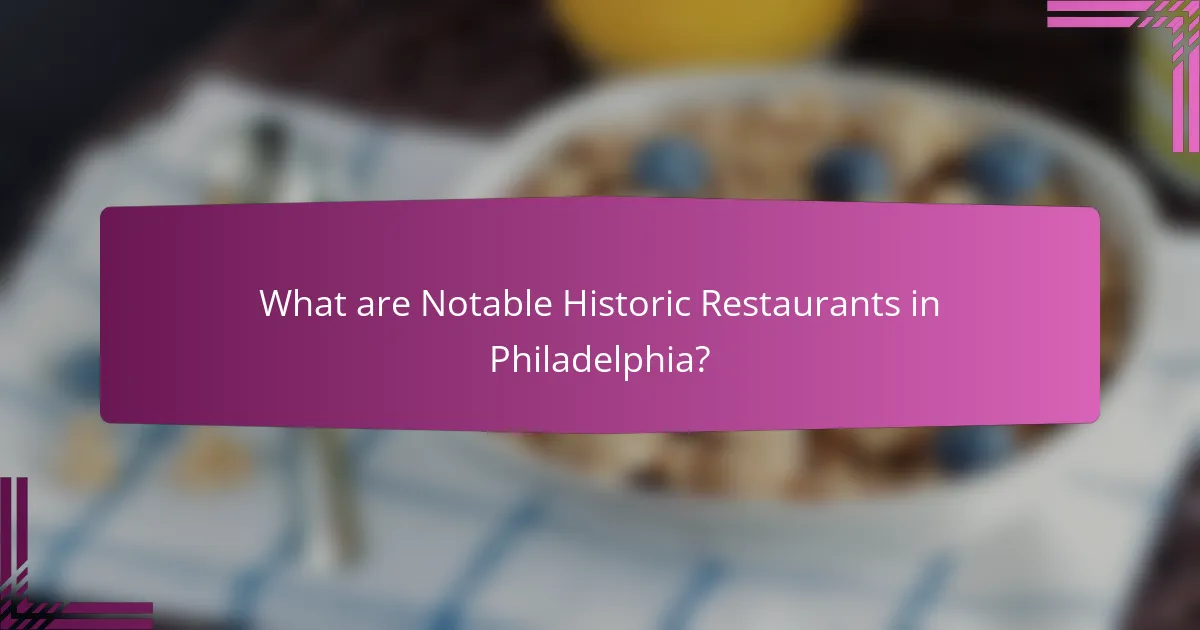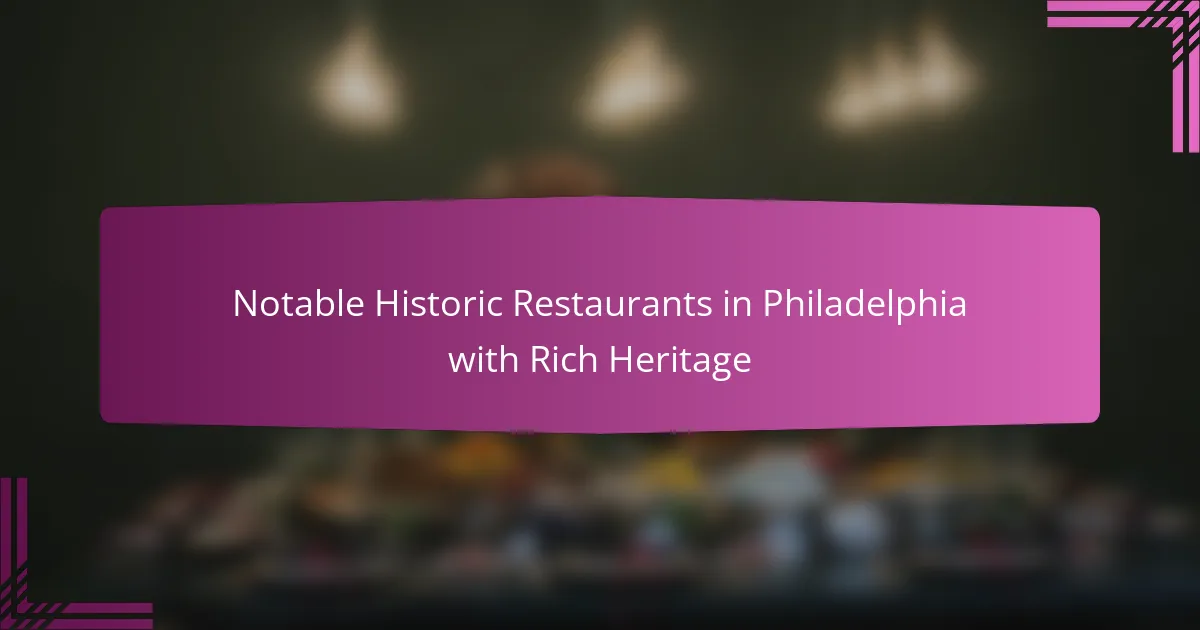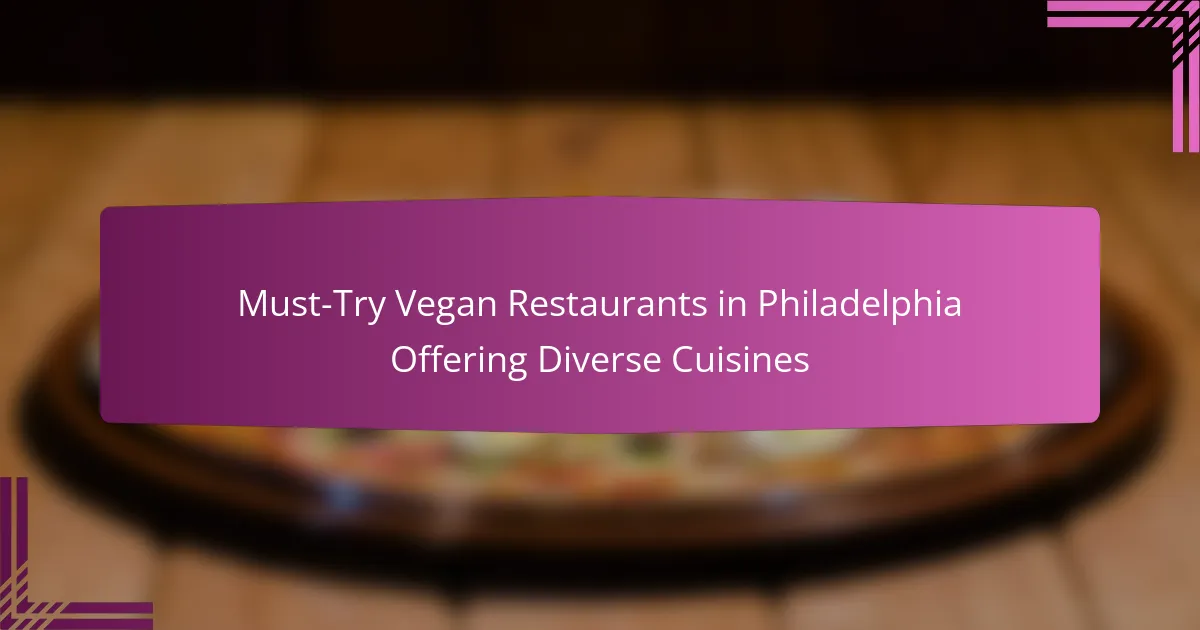
What are Notable Historic Restaurants in Philadelphia?
Notable historic restaurants in Philadelphia include the City Tavern, founded in 1773, and the oldest continuously operating restaurant, the Oyster House, established in 1849. The City Tavern served as a meeting place for Founding Fathers and features a menu inspired by 18th-century recipes. The Oyster House is renowned for its fresh seafood and has been a local favorite for generations. Another significant restaurant is the Franklin Fountain, which opened in 2004 but is designed to evoke the spirit of early 20th-century ice cream parlors. These establishments reflect Philadelphia’s rich culinary history and cultural heritage.
Why is Philadelphia known for its historic restaurants?
Philadelphia is known for its historic restaurants due to its rich culinary heritage and significant historical events. Many of these establishments date back to the 18th and 19th centuries. They often served famous figures during critical moments in American history. For example, City Tavern, established in 1773, hosted Founding Fathers like George Washington and Thomas Jefferson. Other historic restaurants showcase traditional recipes and local ingredients, reflecting the city’s multicultural influences. The preservation of these venues contributes to Philadelphia’s identity as a city steeped in history. Visitors often seek out these restaurants to experience the blend of history and cuisine.
What role do these restaurants play in Philadelphia’s cultural heritage?
These restaurants serve as vital components of Philadelphia’s cultural heritage. They reflect the city’s diverse history and culinary traditions. Many of these establishments have been operational for over a century. They offer traditional dishes that represent various immigrant communities. Historical events often took place within their walls, contributing to local lore. For example, the City Tavern is linked to the founding fathers and early American history. These venues also foster community engagement through food and shared experiences. Their preservation contributes to the city’s identity and attracts tourism. Overall, they embody the rich tapestry of Philadelphia’s cultural narrative.
How do historic restaurants reflect the city’s history?
Historic restaurants reflect the city’s history by showcasing its cultural evolution and culinary traditions. They often feature architecture and decor that represent specific historical periods. For example, many Philadelphia restaurants date back to the colonial era, displaying styles from that time. Menus frequently highlight regional ingredients and dishes that tell stories of local heritage. These establishments often serve as gathering places for significant events in the city’s past. Additionally, they may be associated with famous figures or movements that shaped the community. Historical records indicate that dining venues have played roles in social and political gatherings. This connection to the past enhances the dining experience, making it a living history lesson.
What makes a restaurant historic in Philadelphia?
A restaurant is considered historic in Philadelphia when it has significant historical importance or has been in operation for a long time. These establishments often date back to the 18th or 19th centuries. They may have played a role in key events or movements in American history. Many historic restaurants feature original architecture or decor that reflects their era. They often have a rich narrative linked to notable figures or cultural milestones. For example, some may have served famous patrons or been the site of important meetings. The preservation of their legacy contributes to Philadelphia’s cultural heritage. Historic designations can also be awarded based on their contributions to local cuisine and community identity.
What criteria are used to define historic restaurants?
Historic restaurants are defined by several key criteria. Firstly, they must have significant historical significance, often linked to notable events or figures. Secondly, the establishment should be at least 50 years old, indicating a long-standing presence in the community. Additionally, the architecture or interior design often reflects the period in which the restaurant was established, showcasing historical styles. The menu may also include traditional dishes that have been served for decades, preserving culinary heritage. Lastly, recognition by local or national historic registers can further validate a restaurant’s historic status. These criteria ensure that the restaurant is not only a place to eat but also a site of cultural and historical importance.
How do age and architecture contribute to a restaurant’s historic status?
Age and architecture significantly contribute to a restaurant’s historic status. Older restaurants often reflect the cultural and social history of their time. Their architectural styles can showcase specific design movements, such as Colonial or Victorian, which are tied to particular historical periods. For example, a restaurant housed in a building dating back to the 18th century may be recognized for its role in early American history. Architectural features like original woodwork, stained glass, or brick facades can enhance a restaurant’s appeal and authenticity. Historic preservation laws often protect these buildings, further cementing their status. Restaurants that maintain their original design elements are often seen as cultural landmarks. This combination of age and architectural integrity helps establish a restaurant’s significance in a city’s heritage.
Which notable historic restaurants can be found in Philadelphia?
Some notable historic restaurants in Philadelphia include the City Tavern, the Reading Terminal Market, and the Old Original Bookbinder’s. City Tavern opened in 1773 and served as a meeting place for Founding Fathers. Reading Terminal Market, established in 1893, is a hub for local food vendors and historic dining. Old Original Bookbinder’s, founded in 1865, was famous for its seafood and elegant dining atmosphere. These restaurants reflect Philadelphia’s rich culinary history and cultural significance.
What are the most famous historic restaurants in the city?
The most famous historic restaurants in Philadelphia include City Tavern, founded in 1773. City Tavern served as a meeting place for the Founding Fathers. It is known for its colonial American cuisine. Another notable restaurant is The Oyster House, established in 1849. The Oyster House is famous for its seafood and has a rich history. Additionally, the Reading Terminal Market features many historic food vendors. These establishments reflect Philadelphia’s culinary heritage and historical significance.
What unique attributes do these restaurants possess?
Notable historic restaurants in Philadelphia possess unique attributes such as architectural significance, historical relevance, and distinctive culinary traditions. These establishments often feature original designs from various architectural styles, reflecting the era they were built in. Many have played pivotal roles in local history, serving as meeting places for influential figures. Their menus frequently include recipes passed down through generations, showcasing traditional cooking methods. Some restaurants are located in buildings that are landmarks, adding to their historical charm. Unique decor often highlights local art and memorabilia, enhancing the dining experience. These attributes collectively create a rich cultural heritage that attracts both locals and tourists.
How do the menus of historic restaurants reflect their heritage?
Menus of historic restaurants reflect their heritage through traditional recipes and regional ingredients. These menus often showcase dishes that have been passed down through generations. They highlight the cultural influences of the area’s history, such as colonial or immigrant cuisines. For example, a restaurant may feature dishes that originated from the local community’s ancestral homeland. Furthermore, the presentation of these dishes can reflect historical cooking methods and serving styles. The use of locally sourced ingredients often emphasizes the connection to the region’s agricultural practices. Additionally, menus may include historical anecdotes or references that celebrate the restaurant’s legacy. This combination of elements helps preserve and communicate the culinary heritage of the area.
What traditional dishes are commonly served in these restaurants?
Traditional dishes commonly served in notable historic restaurants in Philadelphia include cheesesteaks, hoagies, and soft pretzels. Cheesesteaks consist of thinly sliced beefsteak and melted cheese in a hoagie roll. Hoagies feature assorted meats, cheeses, and vegetables in a long roll. Soft pretzels are a popular snack, often served with mustard. These dishes reflect Philadelphia’s culinary heritage and are integral to its food culture. The city’s restaurants have been serving these items for decades, making them staples in the local diet.
How do these dishes connect to Philadelphia’s history?
Philadelphia’s dishes connect to the city’s history through their cultural and historical significance. Many iconic foods, like the cheesesteak, emerged in the 20th century and reflect the city’s immigrant influences. Historical restaurants, such as the Reading Terminal Market, showcase traditional recipes that have been passed down through generations. The city’s role as a hub during the American Revolution also influenced local cuisine, with dishes often incorporating ingredients native to the region. Additionally, the culinary landscape of Philadelphia highlights the blend of various cultures, from Italian to African American, shaping the city’s identity. These dishes serve as a testament to Philadelphia’s diverse heritage and evolving food scene.
What dining experiences do historic restaurants in Philadelphia offer?
Historic restaurants in Philadelphia offer unique dining experiences that blend rich history with culinary tradition. These establishments often feature period decor and ambiance that reflect their historical significance. Many menus showcase traditional recipes passed down through generations. Patrons can enjoy classic Philadelphia dishes like cheesesteaks and scrapple. Some restaurants provide guided tours that highlight their historical context. Others host events and themed dinners that celebrate local heritage. Dining in these venues often includes storytelling from staff about the restaurant’s past. Overall, the experience is a combination of food, history, and culture.
How do ambiance and decor enhance the dining experience?
Ambiance and decor significantly enhance the dining experience by creating a specific atmosphere. A well-designed space can evoke emotions and set the mood for the meal. For example, warm lighting can promote relaxation, while vibrant colors can stimulate appetite. Research shows that diners are more likely to enjoy their meals in aesthetically pleasing environments. A study published in the Journal of Consumer Research found that pleasant surroundings can increase satisfaction and perceived food quality. Additionally, decor elements, such as artwork and furniture style, contribute to the restaurant’s theme and identity. This connection can make the dining experience more memorable and enjoyable for patrons.
What kind of service can diners expect at these establishments?
Diners can expect attentive and personalized service at notable historic restaurants in Philadelphia. These establishments often feature knowledgeable staff who can provide insights into the menu and the restaurant’s history. Many offer a warm, welcoming atmosphere that reflects their rich heritage. Patrons may experience traditional dining practices, such as formal table settings and professional waitstaff. Some restaurants may also provide unique dining experiences, like chef’s tables or tasting menus. This service approach enhances the overall dining experience, making it memorable for guests.
How have notable historic restaurants evolved over time?
Notable historic restaurants have evolved through changes in cuisine, dining styles, and cultural influences. Many have adapted their menus to reflect contemporary tastes while preserving traditional dishes. For example, establishments like the City Tavern have incorporated local ingredients to enhance authenticity. Over time, the ambiance of these restaurants has transformed to meet modern expectations, blending historical charm with contemporary design. Additionally, the rise of technology has influenced service methods, including online reservations and digital menus. Historic restaurants have also embraced sustainability practices, sourcing from local farms. This evolution showcases their ability to balance heritage with innovation, ensuring relevance in a changing culinary landscape.
What changes have been made to adapt to modern dining trends?
Historic restaurants in Philadelphia have made several changes to adapt to modern dining trends. These changes include updating menus to feature locally sourced ingredients. Many establishments now offer plant-based options to cater to vegan and vegetarian diners. Enhanced dining experiences are created through open kitchen concepts and interactive dining. Restaurants have also embraced technology by incorporating online reservations and digital menus. Some locations focus on sustainability, reducing waste and using eco-friendly practices. Additionally, the ambiance has been modernized while preserving historical elements. These adaptations reflect a commitment to evolving with consumer preferences and dining habits.
How do these restaurants maintain their historic charm while evolving?
These restaurants maintain their historic charm while evolving by preserving original architectural features. They often retain vintage decor and furnishings that reflect their history. Many restaurants also highlight traditional recipes and cooking methods. This approach connects patrons to the past while introducing modern culinary trends. They may incorporate seasonal ingredients to enhance their menus without losing authenticity. Staff training often includes history lessons to enrich customer experience. Some establishments host events that celebrate their heritage, fostering community engagement. These strategies effectively blend tradition with innovation.
What tips should visitors consider when dining at historic restaurants in Philadelphia?
Visitors should consider making reservations at historic restaurants in Philadelphia. Many of these establishments are popular and can fill up quickly. Arriving early allows guests to enjoy the ambiance and history. Visitors should also ask about the restaurant’s historical significance. This can enhance the dining experience. It’s wise to try signature dishes that reflect the restaurant’s heritage. For example, some places may offer traditional recipes passed down through generations. Guests should be aware of dress codes, as some historic venues may have specific attire requirements. Lastly, reading reviews can provide insights into the dining experience and menu options.
Notable historic restaurants in Philadelphia are establishments with significant historical importance and rich culinary heritage, dating back to the 18th and 19th centuries. Key examples include the City Tavern, which served Founding Fathers, and the Oyster House, renowned for its seafood. These restaurants reflect the city’s cultural evolution through traditional dishes and unique architectural styles, while also adapting to modern dining trends. The article explores the criteria defining historic restaurants, their role in Philadelphia’s cultural narrative, and the dining experiences they offer, emphasizing the connection between food, history, and community engagement.


